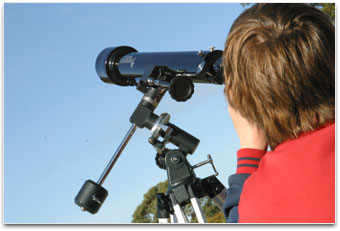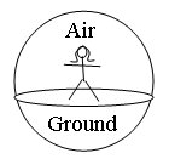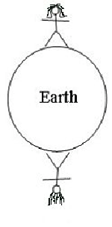This focus idea is explored through:
Contrasting student and scientific views
Student everyday experiences
 Understandably, students have a strong tendency to interpret reality only according to the way it is perceived from their own perspective.
Understandably, students have a strong tendency to interpret reality only according to the way it is perceived from their own perspective.
This has implications for their understandings of ideas that represent objects on a very large scale like the solar system. They observe the world from their own place on a very small region of the Earth. They often find it difficult to comprehend distances in the order of their own country and consequently larger distances like those involved with the solar system are often unimaginable for them. In addition, students observe motion from their own point of reference.
In order to understand the motion of the sun and Earth they must imagine a different point of reference. This can make ideas in this area very challenging for students to grasp.
Research: Nussbaum (1985)
The views held by students about the shape of the Earth are varied and often unique to the individual. Even though students can often articulate that the Earth is a sphere, upon further investigation they often believe in fact that the Earth is how they perceive it, flat. Some children view the Earth as round or circular as opposed to spherical (see diagram 1 below).
Another common view is of the Earth as flat and that it and the air form a sphere (see diagram 2 below). Students can often represent the Earth as a sphere (or circle on the plane of the paper) but they still perceive the person on the
top of the sphere as the upright person (see diagram 3 below).
| Contrasting student and scientific views |
|---|
Diagram 1:
The view is that the Earth is a circular disc floating in the atmosphere. |

|
Diagram 2:
The view that the air and Earth form equal hemispheres and the observer is located centrally. |

|
Diagram 3:
The view is that observers are located around the surface of the Earth but ‘down’ is not towards the centre of the Earth, but towards the bottom of the page.
Note: the girl’s hair still hangs ‘down’. |

|
Research: Nussbaum (1985)
Students hold a range of views which they use to explain day and night:
- the sun shines during the day and the moon shines at night
- the sun and the moon are on different sides of the Earth and the Earth rotates facing one and then the other
- the sun goes around the Earth
- the sun moves to cause day and night
- a day is the time it takes the Earth to move around the sun
- a day is the time it takes for the sun to move around the Earth
- night occurs when the moon covers the sun
- night occurs when clouds cover the sun.
Research: Nussbaum (1985), Skamp (2004)
These views are also evident in and related to the focus idea
Forces without contact.
Scientific view
The Earth is one of several planets that orbit the sun, and the moon orbits the Earth. The Earth is essentially a sphere and the sun is a nearby star which is an unimaginably large ball of gas that radiates light and heat as products of nuclear reactions.
 The Earth orbits the sun once every 365 days and rotates about its axis once every 24 hours. Day and night are due to the Earth rotating on its axis, not its orbiting around the sun. The term ‘one day’ is determined by the time the Earth takes to rotate once on its axis and includes both day time and night time.
The Earth orbits the sun once every 365 days and rotates about its axis once every 24 hours. Day and night are due to the Earth rotating on its axis, not its orbiting around the sun. The term ‘one day’ is determined by the time the Earth takes to rotate once on its axis and includes both day time and night time.
Critical teaching ideas
- The Earth is a sphere and the sun is a star and produces light.
- The Earth and sun are part of the solar system, with the sun at its centre.
- An Earth day is 24 hours because the Earth spins on its axis once every 24 hours.
- At any one time half of the Earth’s sphere is in sunlight (day) while the other half is in darkness (night).
 Explore the relationships between ideas about day and night in the
Concept Development Maps - (Gravity, Stars, Solar System)
Explore the relationships between ideas about day and night in the
Concept Development Maps - (Gravity, Stars, Solar System)
Students are often interested and highly motivated to learn about ideas about space and care must be taken to avoid the overuse of library and internet sources and to ensure that students are engaged and thinking about secondary sources of information.
Students should be encouraged to make use of observable features of astronomy. These observations can be made during the day as well as at night. They should then be guided to develop their own questions to research and explore. In this way the research is more directed and not simply a fact finding exercise.
Students’ preconceptions should be identified and then their understanding should be guided and developed through discussion and hands-on activities. Opportunities to make models and to manipulate the models to help students explain their ideas should be provided.
The manipulation of models also assists students to view the motion of the sun, Earth and the moon from a new perspective of an observer of the whole system as opposed to their usual perspective as an observer on a very small region on the surface of the Earth.
Teaching activities
Bring out students’ existing ideas
Students could be asked to create a concept map using the terms such as: ‘sun’, ‘stars’, ‘space’, ‘Earth’, ‘day’ and ‘night; to elicit their prior ideas about astronomy. This can be used as a starting point to challenge existing ideas and to explore new ideas
Research: Skamp (2004)
Promote reflection and clarification of existing ideas
Student drawings and their associated explanations of the motion of the Earth and sun can be used to challenge their existing ideas and to help them to reflect on their understanding.
Clarify and consolidate ideas for/by communication to others
To help students move from their usual perspective of an observer on a small part of the Earth to an observer outside the Earth simulation computer programs or websites can be used. A series of helpful images are the ‘Powers of 10’ images which provide insights into scale from the cellular level to galaxies. Students could present posters or diagrams suitable for display on an overhead or data projector to help them to interpret and share new perspectives with their peers.
Some websites to visit include:
Students could also explore indigenous interpretations of the motion of the sun and Earth. Some useful sites are:
Further resources
Science related interactive learning objects can be found on the
FUSE Teacher Resources page.
To access the interactive learning object below, teachers must login to FUSE and search by Learning Resource ID:
-
Earth Rotation: Sky Watch – Turn an animated model of the Earth to explore how rotation affects the view of objects in the sky. Use a camera on the Earth's surface to compare views of sunrise, sunset, the movement of the Moon and position of the stars. Compare views from space with views from the Earth. Answer a series of questions by experimenting with the model. For example, work out the time of day from given views. This learning object is one in a series of four objects.
Learning Resource ID: 68GQQZ